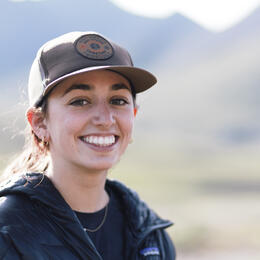In an effort to uplift Indigenous voices, I—Julia Johnston, Audubon Public Lands and Climate Change intern and participant in the Imago Initiative—had the privilege of interviewing elders while in the Arctic National Wildlife Refuge. We spoke about climate change, visions for the Refuge, and (of course) birds. Some of the Iñupiat and Gwich’in elders that I interviewed live in or near the Refuge. Others told stories passed from family and friends. Robert Thompson, Sarah James, Nutaaq Simmonds, and Victoria Hykes-Steere each shared incredible insights.
These recordings became the Voices of the Arctic podcast series. I am honored to have had this experience, and I hope that you enjoy listening to these conversations as much as I enjoyed participating in them.
But first, I’d like to recall my time in the Arctic National Wildlife Refuge.

Soft moss-covered ground speckled with healing plants and flowers, rocks covered with lichen thousands of years old, and mountains rising over the meandering Hulahula River—these are the sights of Grasser’s Airstrip in the Refuge when all creatures are quiet.
In a flutter of activity, a bear runs down the mountainside, wolves pace across the landscape, thousands of caribou cross through the valley, and the wandering tattler gives its chick a swimming lesson in the river.
I’m grateful for each moment I spent on the ancient land of the Iñupiat and Gwich’in peoples. It is easy to form a connection to such a beautiful place, and being there reaffirmed my belief that this land should never be drilled for oil.
However, it also challenged my understanding of conservation.
I went to the Refuge a few summers ago with the Imago Initiative, a program created by the Wilderness Society Alaska state director Karlin Itchoak. The Imago Initiative aims to bring an Indigenous worldview to conservation, which I understand means including, crediting, and uplifting Indigenous voices in conservation. Our trip was part of an effort to engage in place-based dialogue. Essentially, conservationists, Native rights advocates, Indigenous people, and valued friends all convened in a base camp on Grasser’s Airstrip to talk about the Refuge, in the Refuge.
In the warm glow from inside an orange Labvu gathering tent from the Sami people in Norway, I became familiar with the Refuge via a patchwork of personal anecdotes offered by the people around me. We shared tears and laughter as we explored our personal connections to the land and each other. In these circles, I learned about the complicated political history surrounding the Refuge in tandem with the spiritual connection held between Indigenous people and the land. I heard about the realities of the past as the people around me shared their visions for the future.
And all the while I unlearned the simplified narrative that I had in my head about the Refuge.
I’ll be honest—I felt out of my element. While aware of the Refuge and supportive of its conservation, I knew little about the history of the place when I landed on that riverbank in a Bush plane. Meanwhile, Indigenous elders and lifelong conservationists joined me on this trip. I was on my learning edge the entire time, soaking up knowledge from every conversation. I realized that, while I felt ignorant compared to the people around me, I represented most people in knowing little about the history of the Refuge, the Iñupiat, and the Gwich’in. I realized how easy it is to focus on science and policy in the conservation field and leave out a critical element: the people. Visiting the Arctic National Wildlife Refuge with the Imago Initiative gave me the push I needed toward a more humane path in conservation that includes Indigenous people and honors their knowledge and rights.
One message emerged repeatedly in the many conversations I had on this trip. While animals and vegetation thrive freely in the Refuge, the land is not “untouched.” Indigenous people—specifically the Iñupiat and the Gwich’in—have stewarded this land since time immemorial and continue to fight for the land’s health. Their perspectives matter. Their knowledge should be valued and credited. Their rights should be prioritized.
I am just beginning to educate myself about Indigenous-led conservation, and I urge you to join me. Know the Indigenous people who steward the lands that you care about. Uplifting their voices will not only make conservation efforts more inclusive but will also make them more effective and long-lasting.
###
Julia Johnston interned for Audubon Alaska in the summer of 2021, during which she enjoyed getting to live in Anchorage and exploring the beautiful state. She graduated from the University of Michigan in 2022. She is passionate about environmental policy and continues to work in the field in Washington, DC.
The Imago Initiative is a program of The Wilderness Society created by Alaska State Director Karlin Itchoak and supported by Audubon Alaska. The Imago Initiative aims to do conservation with an Indigenous worldview, meaning including, crediting, and uplifting Indigenous voices in the conservation field. The Arctic National Wildlife Refuge is the traditional land of the Gwich'in and Iñupiat peoples who have stewarded the land since time immemorial.




